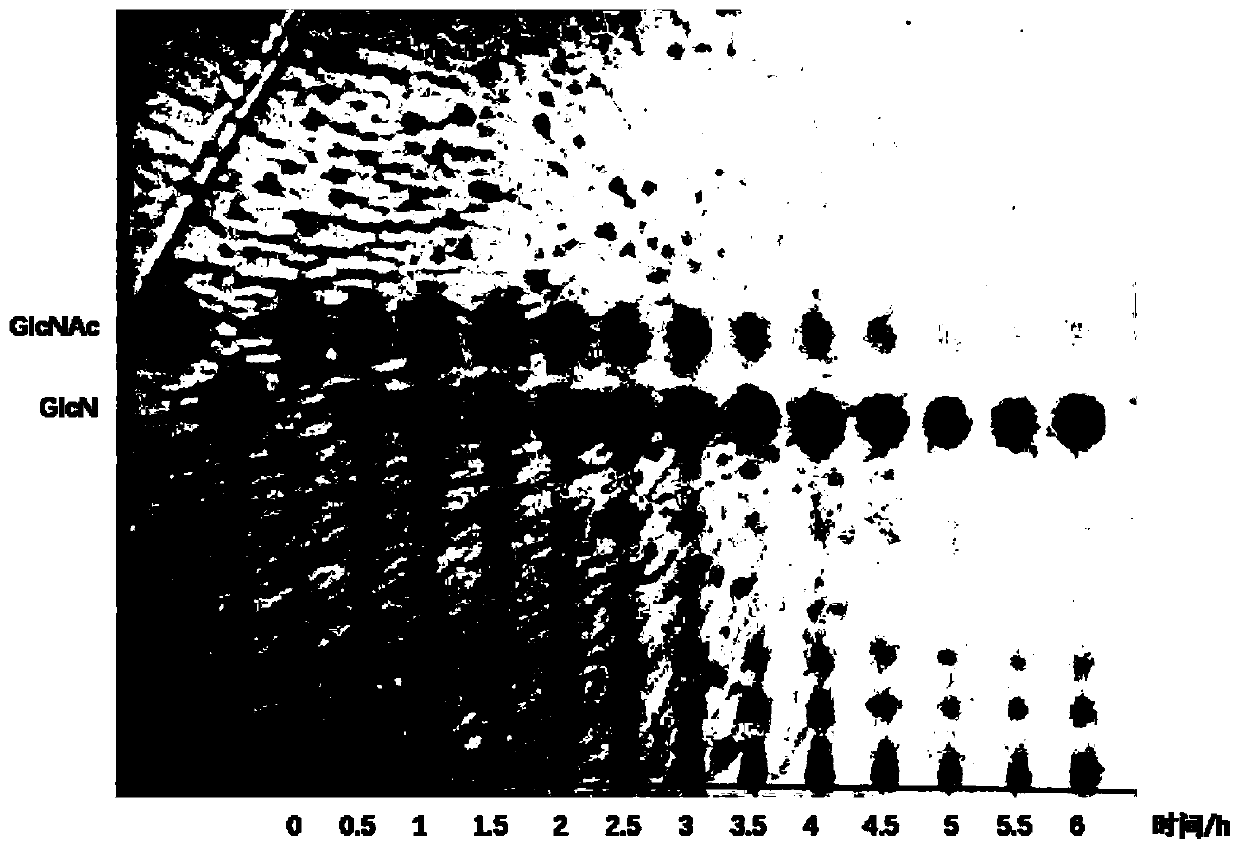Heat-resistant N-acetylglucosamine deacetylase and encoding gene and application thereof
A technology of deacetylase and acetylamino, which is applied to heat-resistant N-acetylglucosamine deacetylase and its encoding gene and application field, can solve the problems of low catalytic conversion rate, limited application of enzymatic deacetylation and the like, and achieves good performance. Application value, good enzymatic properties, good heat resistance
- Summary
- Abstract
- Description
- Claims
- Application Information
AI Technical Summary
Problems solved by technology
Method used
Image
Examples
Embodiment 1
[0061] Embodiment 1, the acquisition of gene TcDac and the construction of expression vector
[0062] According to the above method, the candidate genes were screened from the gene database.
[0063] A candidate gene shown in positions 1-798 of SEQ ID NO.1 is named gene TcDac, and the protein encoded by the gene is named protein TcDac, and its amino acid sequence is shown in SEQ ID NO.2.
[0064] According to the DNA sequence information shown in SEQ ID NO.1, the target gene is artificially synthesized.
[0065] The upstream primer TcDac-up1 (5'-ATGTTTGAGGATGTGAACG-3') and the downstream primer TcDac-down1 (5'-AATCAGCTCCGCGAAG-3',) were designed, and the target DNA fragment was amplified by PCR. The PCR amplification conditions were as follows: pre-denaturation at 94°C for 5 min; denaturation at 94°C for 30 s, annealing at 55°C for 30 s, extension at 72°C for 2 min, and 30 cycles; finally, extension at 72°C for 10 min. PCR products were recovered by 1% agarose gel electropho...
Embodiment 2
[0071] Embodiment 2, expression and purification of recombinant N-acetylglucosamine deacetylase (TcDac)
[0072] The present invention also relates to the construction of a recombinant host cell for expressing TcDac, which comprises the nucleotide encoding TcDac described in the present invention. A host cell can be any cell useful in the recombinant production of proteins of the present invention, such as prokaryotic or eukaryotic cells.
[0073] The prokaryotic host cell can be any gram-positive or gram-negative bacterium, including but not limited to: Bacillus, Clostridium, Lactobacillus, Streptomyces, Staphylococcus, Escherichia coli, Pseudomonas, Paenibacillus.
[0074] Eukaryotic host cells can be mammalian, insect, plant or fungal cells, including but not limited to: filamentous fungi (Aspergillus, Mucor, Rhizopus, Penicillium, etc.), yeasts (Pichia pastoris, Candida spp. yeast, etc.).
[0075] In one embodiment, the expression host cell selected in the present inven...
Embodiment 3
[0079] Example 3, Construction of Pichia pastoris expression system of N-acetylglucosamine deacetylase (TcDac) and high-density fermentation to obtain recombinant protein
[0080] 1. Yeast expression system construction
[0081] Design the upstream primer TcDac-EcoRI (5'-ATTCCG GAATTC ATGTTTGAGGATGTGAACG-3', the underline indicates the EcoRI restriction site) and the downstream primer TcDac-NotI (5'-ATAAGAAT GCGGCCGCTTAAATCAGCTCCGCGAAG-3', the underline shows the NotI restriction site), and using the DNA fragment obtained in the above-mentioned Example 1 as a template, PCR amplifies the amino acid sequence encoding the mature protein. The amplification conditions were: pre-denaturation at 94°C for 5 min; denaturation at 94°C for 30 s, annealing at 55°C for 30 s, extension at 72°C for 1 min, and 30 cycles; finally, extension at 72°C for 5 min. The product was recovered by 1% agarose gel electrophoresis and digested with EcoRI and NotI. The digested product was ligated with...
PUM
| Property | Measurement | Unit |
|---|---|---|
| molecular weight | aaaaa | aaaaa |
| quality score | aaaaa | aaaaa |
Abstract
Description
Claims
Application Information
 Login to View More
Login to View More - R&D
- Intellectual Property
- Life Sciences
- Materials
- Tech Scout
- Unparalleled Data Quality
- Higher Quality Content
- 60% Fewer Hallucinations
Browse by: Latest US Patents, China's latest patents, Technical Efficacy Thesaurus, Application Domain, Technology Topic, Popular Technical Reports.
© 2025 PatSnap. All rights reserved.Legal|Privacy policy|Modern Slavery Act Transparency Statement|Sitemap|About US| Contact US: help@patsnap.com


